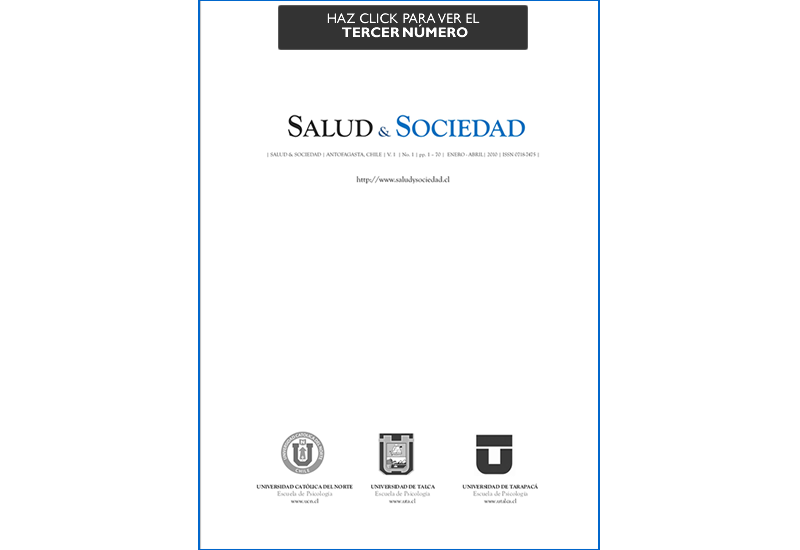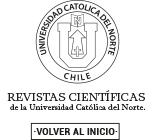CREACIÓN DE UN INDICADOR DE IMPACTO DE TERREMOTOS A PARTIR DE DATOS RECOGIDOS EN PERSONAS QUE VIVIERON EL 27-F
DOI:
https://doi.org/10.22199/S07187475.2010.0003.00003Keywords:
Índice de impacto, Terremoto, Ataque de pánico, 27 de febrero de 2010, Impact index, Earthquake, Panic attack, 27th February 2010,Abstract
El 27 de febrero de 2010 la zona central de Chile sufrió un terremoto como pocos en la historia mundial. Este estudio cuantifica el impacto de este evento mediante la creación de un indicador de impacto de terremotos en las personas (IITP). Para esto, se midieron en 264 participantes las siguientes variables: daño físico de la vivienda, coste de los enseres perdidos, distancia del domicilio al epicentro y cantidad de síntomas de pánico. Luego, se realizan dos análisis factoriales: exploratorio (AFE) para extraer un factor común (impacto) y cuantificarlo; y confirmatorio (AFC) para conocer el ajuste del modelo. Posteriormente, mediante un análisis de regresión lineal múltiple se obtienen los coeficientes que permiten definir el IITP. Los resultados evidencian el adecuado ajuste del modelo (CMIN=1.374, RMSEA=.038, NFI=.921 y CFI=.974) además del buen funcionamiento del IITP. Se confirma que el impacto fue mayor en las zonas costeras afectadas por el terremoto y el tsunami. Finalmente se expone la utilidad de esta nueva herramienta que permite cuantificar el impacto de un evento catastrófico como éste mediante 16 preguntas.
On February 27, 2010 central Chile suffered an earthquake as few in world history. This study tries to quantify the effect of this event by creating of one indicator of earthquake impact in people (IIEP). For this, the following variables were measured, in a sample of 264 people: physical damage of houses, cost of the lost belongings, home distance from the epicenter and number of symptoms of panic attack. Two factor analyses were performed: an exploratory (EFA) to extract a common factor (impact) and quantify it; and a confirmatory (CFA) to determine the fit of the model. Subsequently, by a multiple linear regression, the coefficients were used to define the IIEP. The results demonstrate the very adequate model fit (CMIN=1.374, RMSEA=.038, NFI=.921 and CFI=0.974) in addition to the adequate operation of the IIEP. In fact, it predicted that the impact was greater in coastal areas affected by the earthquake and tsunami. Finally we explain the usefulness of this new tool to quantify the impact of a catastrophic event like this, with 16 questions.
References
Bandura, A. (1974). Behavior theory and models of man. American Psychologist, 29(12), 859-869.
Bokszczanin, A. (2008). Parental support, family conflict, and overprotectiveness: Predicting PTSD symptom levels of adolescents 28 months after a natural disaster. Anxiety, Stress, y Coping, 21(4), 325-335.
Cairo, JB., Dutta, S. y Nawaz, H. (2010). The prevalence of posttraumatic stress disorder among adult earthquake survivors in Peru. Disaster Medicine and Public Health Preparedness, 4, 39-46.
Carr, VJ., Lewin, TJ., Kenardy, JA., Webster, RA., Hazell, PL., Carter, GL. y Williamson, M. (1997). Psychosocial sequelae of the 1989 Newcastle earthquake: III. Role of vulnerability factors in postdisaster morbidity. Psychological Medicine, 27, 179–190.
Goenjian, AK., Noble, EP., Walling, DP., Goenjian, AG., Karayanc, IS., Ritchieb, T. y Bailey, JN. (2008). Heritabilities of symptoms of posttraumatic stress disorder, anxiety, and depression in earthquake exposed Armenian families. Psychiatric Genetics, 18(6), 261-266.
Goenjian, AK., Steinberg, AM., Najarian, LM., Fairbanks, LA., Tashjian, M. y Pynoos, RS. (2000). Prospective study of posttraumatic stress, anxiety, and depressive reactions after earthquake and political violence. American Journal of Psychiatry, 157(6), 911–916.
Groome, D. y Soureti, A. (2004). Post-traumatic stress disorder and anxiety symptoms in children exposed to the 1999 Greek earthquake. British Journal of Psychology 95, 387–397.
Hair, J.F., Anderson, R.E., Tatham, R.L. y Black, W.C. (2004). Multivariate data analysis. New Jersey. Prentice Hall International Inc.
Harville, EW., Xiong, X., Buekens, P., ElkindHirsch, K. y Pridjian, G. (2009). Posttraumatic stress disorder, depression, and resilience after hurricane Gustav. American Journal of Epidemiology, 169(Suppl): S1–S137.
INE-Instituto Nacional de Estadísticas (2003). Censo 2002: Síntesis de Resultados. Santiago de Chile: La Nación S.A.
Kanfer, R. y Phillips, J. (1980). Principios de Aprendizaje en la Terapia del Comportamiento. México: Trillas.
Kar, N. (2009). Psychological impact of disasters on children: review of assessment and interventions. World Journal of Pediatrics, 5(1), 5-11.
Kar, N., Mohapatra, PK., Nayak, KC., Pattanaik, P., Swain, SP. y Kar, HC. (2007). Posttraumatic stress disorder in children and adolescents one year after a super-cyclone in Orissa, India: exploring cross-cultural validity and vulnerability factors. BMC Psychiatry, 7(8), 1-9.
Khan, M., Masood, M., Mukhtar, M., Sana, N. y Chaudhry, H. (2010). Gender differences in prevalence of anxiety disorders among earth quake survivors. 18th European Congress of Psychiatry, 25(1), 351.
Lai, TJ, Chang, CM, Connor, KM, Lee, LC y Davidson, JR (2004). Fulland partial PTSD among earthquake survivors in rural Taiwan. J. Psychiatr. Res. 38(3):313–322.
Leiva, M. y Quintana, G. (en prensa). Factores ambientales y psicosociales vinculados con los síntomas de ataque de pánico después del terremoto y tsunami del 27 de Febrero en pobladores de la zona central de Chile. Terapia Psicológica.
López-Ibor, JJ. y Valdés, M. (2008). DSM-IV. Manual diagnóstico y estadístico de los trastornos mentales. Madrid: Masson.
McFarlane, AC. y Papay P. (1992). Multiple diagnoses in posttraumatic stress disorder in the victims of a natural disaster. Journal of Nervous and Mental Disease, 180, 498–504.
Ministerio del Interior-Gobierno de Chile (2010a). Fallecidos confirmados con RUT y certificado de defunción de registro civil (actualizado al 15/04/2010). Extraído el 14 de Julio desde: http://www.interior.gov.cl/
Ministerio del Interior-Gobierno de Chile (2010b). Denuncias por presunta desgracia relacionadas con el terremoto y maremoto del 27 de febrero (actualizado al 15/04/2010). Extraído el 14 de Julio desde: http://www.interior.gov.cl/
Önder, E., Tural, Ü., Aker, T., K?l?c, C. y Erdo?an, S. (2006). Prevalence of psychiatric disorders three years after the 1999 earthquake in Turkey: Marmara Earthquake Survey (MES). Social Psychiatry and Psychiatric Epidemiology, 41, 868–874.
Pardo, A. y Ruiz, M. (2005). Análisis de datos con SPSS 13 Base. Madrid: Mc Graw Hill.
Priebe, S., Grappasonni, I., Mari, M., Dewey, M., Petrelli, F. y Costa, A. (2009). Posttraumatic stress disorder six months after an earthquake. Social Psychiatry and Psychiatric Epidemiology, 44(5), 393-397.
Riquelme, P. (2010a, 28 de febrero). Tres enormes olas devastan Constitución tras sismo. La Tercera, 8-9.
Riquelme, P. (2010b, 03 de marzo). El terremoto en Chile deja 795 muertos y dos millones de damnificados. Europapress.
Rochanakorn, K. (2007). IASC Guidelines on Mental Health and Psychosocial Support in Emergency Settings. Geneva: IASC.
Rodríguez, J. Zaccarelli, M. y Pérez, R. (2006). Guía práctica de salud mental en situaciones de desastres. Washington D.C.: PAHO.
Sharan, P., Chaudhary, G., Kavathekar, S. y Saxena, S. (1996). Preliminary report of psychiatric disorders in survivors of a severe earthquake. American Journal of Psychiatry, 153(4), 556-558.
Solvason, HB., Ernst, H. y Roth, W. (2003). Predictors of response in anxiety disorders. Psychiatric Clinics of North America, 26, 411–433.
Taylor, S. (1992). How does anxiety sensitivity vary across the anxiety disorders? Journal of Anxiety Disorder, 6, 249-259.
Thienkrua, W., Lopes Cardozo, B., Somchai Chakkraband, ML., Guadamuz, TE., Pengjuntr, W., Tantipiwatanaskul, P., Sakornsatian, S., Ekassawin, S., Panyayong, B., Varangrat, A., Tappero, JW., Schreiber, M. y van Griensven, F. (2006). Symptoms of posttraumatic stress disorder and depression among children in tsunami-affected areas in southern Thailand. Journal of the American Medical Association, 296(5), 549-559.
Ticehurst, S., Webster, RA., Carr, VJ. y Lewin, TJ. (1996). The psychosocial impact of an earthquake on the elderly. International Journal of Geriatric Psychiatry, 11, 943-951.
USGS - United States Geological Survey (2010). Tsunami and earthquake research. Descargado el 14 de julio de 2010 de: http://walrus.wr.usgs.gov/tsunami/
Ximénez, C. y San Martín, R. (2004). Fundamentos de las técnicas multivariantes. Madrid. UNED Ediciones.
Published
How to Cite
Issue
Section
Los autores continúan como propietarios de sus trabajos, y pueden volver a publicar sus artículos en otro medio sin tener que solicitar autorización, siempre y cuando indiquen que el trabajo fue publicado originariamente en Revista Salud & Sociedad (ISSNe:0718-7475).



_(1).png)





